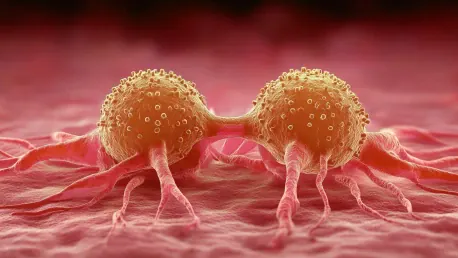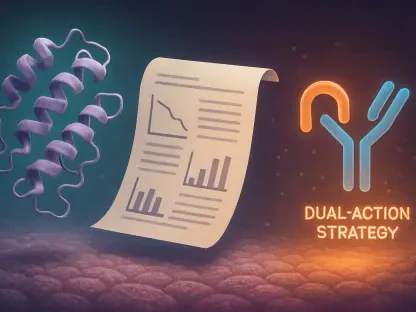In the relentless pursuit of enhanced cancer treatments, recent research has shed light on the dual inhibition of MYCN and MDM2 as a promising strategy. Both MYCN and MDM2 are vital oncogenes implicated in various tumorigenic processes. Their simultaneous targeting might revolutionize the therapeutic landscape, especially for neuroblastoma. This article delves into the role of these oncogenes, their interactions, and the potential of dual-targeting approaches in improving cancer therapy outcomes.
Understanding the Oncogenes: MYCN and MDM2
The Role of MYCN in Cancer Development
MYCN, a member of the MYC family of proteins, is critical in regulating cell growth, differentiation, and apoptosis. Its dysregulation has been closely linked to the onset and progression of various cancers, particularly neuroblastoma. Overexpression of MYCN drives uncontrolled proliferation and contributes to the formation of malignant tumors. Given its significant role in cancer biology, MYCN has become a focal point for therapeutic interventions. Inhibiting MYCN can disrupt essential cellular processes in cancer cells, hindering their survival and proliferation.
Moreover, MYCN amplification in tumors is associated with poor prognosis and aggressive disease behavior. Targeting MYCN is not only about halting tumor growth but also addressing the mechanisms that prevent effective treatment. The oncogenic properties of MYCN make it a prime candidate for novel cancer therapies, aiming to limit its activity and mitigate its tumor-promoting effects. Preclinical models have demonstrated that MYCN inhibition can lead to tumor regression, emphasizing the potential benefits of this approach in clinical settings.
MDM2 and Its Intersection with MYCN
MDM2 is an oncogene predominantly known for its role in regulating the tumor suppressor protein p53. By negatively controlling p53, MDM2 promotes cancer cell survival and proliferation. The interaction between MYCN and MDM2 adds another layer of complexity to cancer biology, as both proteins are involved in reinforcing each other’s oncogenic effects. MDM2 can help stabilize MYCN, making it more potent in driving tumor growth. This symbiotic relationship makes dual-targeting an appealing strategy for therapeutic development.
The MDM2/p53 axis plays a pivotal role in tumorigenesis, as highlighted by numerous studies. Inhibiting MDM2’s function can reactivate p53, leading to apoptosis and growth arrest in cancer cells. This has important implications for neuroblastoma and other malignancies where both MYCN and MDM2 play critical roles. Comprehensively targeting both proteins could simultaneously disrupt multiple survival pathways in cancer cells, offering a more robust anticancer effect. The rationale behind dual-targeting lies in dismantling these intersecting pathways, presenting a new frontier in cancer treatment strategies.
Potential of Dual-Targeting Approaches
Synergistic Effects of MYCN and MDM2 Inhibition
Targeting both MYCN and MDM2 simultaneously could produce synergistic effects, enhancing the overall efficacy of cancer therapy. Each protein’s involvement in vital oncogenic pathways suggests that their dual inhibition could impede tumor growth more effectively than targeting either one alone. This strategy could disrupt the feedback loop between MYCN and MDM2, leading to significant retardation of cancer progression. Such an approach could be particularly advantageous in treating aggressive forms of cancer that are resistant to conventional therapies.
The idea of combination therapies integrating multiple modes of action is gaining momentum in the oncology field. Dual-targeting MYCN and MDM2 fits into this broader trend, leveraging insights from both molecular biology and therapeutic innovation. By concurrently inhibiting these key oncogenes, researchers aim to achieve deeper and more sustained responses in patients. Preclinical studies have provided encouraging data supporting the feasibility and potential benefits of such approaches. Clinical trials will be crucial in validating these findings and translating them into effective treatment options.
Challenges and Future Directions
In the relentless quest for better cancer treatments, recent research has highlighted the dual inhibition of MYCN and MDM2 as a promising approach. MYCN and MDM2 are vital oncogenes involved in various cancerous processes, and targeting them both at once could revolutionize treatment, particularly for neuroblastoma. Neuroblastoma is a challenging pediatric cancer, often involving high-risk cases that are difficult to treat with traditional methods. MYCN amplification is a common feature in aggressive forms of this disease, and MDM2 is known for its role in inhibiting the p53 tumor suppressor pathway. By simultaneously targeting these oncogenes, the new strategy aims to disrupt their interaction, thereby halting tumor progression and enhancing patient outcomes. This dual-targeting approach holds potential not only for effectively treating neuroblastoma but also for application in other cancers where MYCN and MDM2 play critical roles. Researchers continue to explore the therapeutic landscape, hoping that these insights will lead to more effective cancer therapies and improve survival rates.









